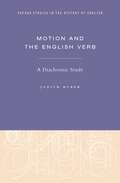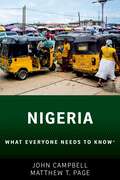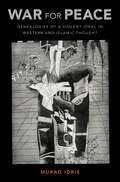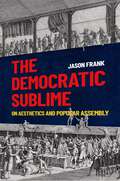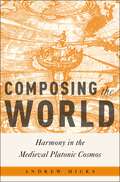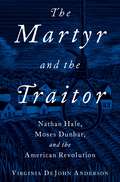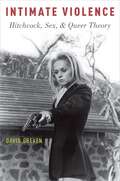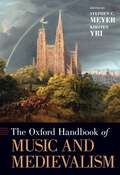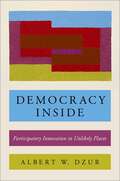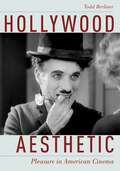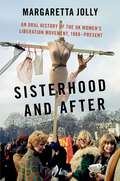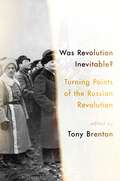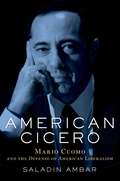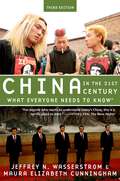- Table View
- List View
Motion and the English Verb: A Diachronic Study (Oxford Studies in the History of English)
by Judith HuberIn Motion and the English Verb, a study of the expression of motion in medieval English, Judith Huber provides extensive inventories of verbs used in intransitive motion meanings in Old and Middle English, and discusses these in terms of the manner-salience of early English. Huber demonstrates how several non-motion verbs receive contextual motion meanings through their use in the intransitive motion construction. In addition, she analyzes which verbs and structures are employed most frequently in talking about motion in select Old and Middle English texts, demonstrating that while satellite-framing is stable, the extent of manner-conflation is influenced by text type and style. Huber further investigates how in the intertypological contact with medieval French, a range of French path verbs (entrer, issir, descendre, etc.) were incorporated into Middle English, in whose system of motion encoding they are semantically unusual. Their integration into Middle English is studied in an innovative approach which analyzes their usage contexts in autonomous Middle English texts as opposed to translations from French and Latin. Huber explains how these verbs were initially borrowed not for expressing general literal motion, but in more specific, often metaphorical and abstract contexts. Her study is a diachronic contribution to the typology of motion encoding, and advances research on the process of borrowing and loanword integration.
Motion and the English Verb: A Diachronic Study (Oxford Studies in the History of English)
by Judith HuberIn Motion and the English Verb, a study of the expression of motion in medieval English, Judith Huber provides extensive inventories of verbs used in intransitive motion meanings in Old and Middle English, and discusses these in terms of the manner-salience of early English. Huber demonstrates how several non-motion verbs receive contextual motion meanings through their use in the intransitive motion construction. In addition, she analyzes which verbs and structures are employed most frequently in talking about motion in select Old and Middle English texts, demonstrating that while satellite-framing is stable, the extent of manner-conflation is influenced by text type and style. Huber further investigates how in the intertypological contact with medieval French, a range of French path verbs (entrer, issir, descendre, etc.) were incorporated into Middle English, in whose system of motion encoding they are semantically unusual. Their integration into Middle English is studied in an innovative approach which analyzes their usage contexts in autonomous Middle English texts as opposed to translations from French and Latin. Huber explains how these verbs were initially borrowed not for expressing general literal motion, but in more specific, often metaphorical and abstract contexts. Her study is a diachronic contribution to the typology of motion encoding, and advances research on the process of borrowing and loanword integration.
Nigeria: What Everyone Needs to Know® (What Everyone Needs To Know®)
by John Campbell Matthew T. PageAs the "Giant of Africa" Nigeria is home to about twenty percent of the population of Sub-Saharan Africa, serves as Africa's largest producer of oil and natural gas, comprises Africa's largest economy, and represents the cultural center of African literature, film, and music. Yet the country is plagued by problems that keep it from realizing its potential as a world power. Boko Haram, a radical Islamist insurrection centered in the northeast of the country, is an ongoing security challenge, as is the continuous unrest in the Niger Delta, the heartland of Nigeria's petroleum wealth. There is also persistent violence associated with land and water use, ethnicity, and religion. In Nigeria: What Everyone Needs to Know®, John Campbell and Matthew Page provide a rich contemporary overview of this crucial African country. Delving into Nigeria's recent history, politics, and culture, this volume tackles essential questions related to widening inequality, the historic 2015 presidential election, the persistent security threat of Boko Haram, rampant government corruption, human rights concerns, and the continual conflicts that arise in a country that is roughly half Christian and half Muslim. With its continent-wide influence in a host of areas, Nigeria's success as a democracy is in the fundamental interest of its African neighbors, the United States, and the international community. This book will provide interested readers with an accessible, one-of-a-kind overview of the country.
NIGERIA WENK C: What Everyone Needs to Know® (What Everyone Needs To Know®)
by John Campbell Matthew T. PageAs the "Giant of Africa" Nigeria is home to about twenty percent of the population of Sub-Saharan Africa, serves as Africa's largest producer of oil and natural gas, comprises Africa's largest economy, and represents the cultural center of African literature, film, and music. Yet the country is plagued by problems that keep it from realizing its potential as a world power. Boko Haram, a radical Islamist insurrection centered in the northeast of the country, is an ongoing security challenge, as is the continuous unrest in the Niger Delta, the heartland of Nigeria's petroleum wealth. There is also persistent violence associated with land and water use, ethnicity, and religion. In Nigeria: What Everyone Needs to Know®, John Campbell and Matthew Page provide a rich contemporary overview of this crucial African country. Delving into Nigeria's recent history, politics, and culture, this volume tackles essential questions related to widening inequality, the historic 2015 presidential election, the persistent security threat of Boko Haram, rampant government corruption, human rights concerns, and the continual conflicts that arise in a country that is roughly half Christian and half Muslim. With its continent-wide influence in a host of areas, Nigeria's success as a democracy is in the fundamental interest of its African neighbors, the United States, and the international community. This book will provide interested readers with an accessible, one-of-a-kind overview of the country.
War for Peace: Genealogies of a Violent Ideal in Western and Islamic Thought
by Murad IdrisPeace is a universal ideal, but its political life is a great paradox: "peace" is the opposite of war, but it also enables war. If peace is the elimination of war, then what does it mean to wage war for the sake of peace? What does peace mean when some say that they are committed to it but that their enemies do not value it? Why is it that associating peace with other ideals, like justice, friendship, security, and law, does little to distance peace from war? Although political theory has dealt extensively with most major concepts that today define "the political" it has paid relatively scant critical attention to peace, the very concept that is often said to be the major aim and ideal of humanity. In War for Peace, Murad Idris looks at the ways that peace has been treated across the writings of ten thinkers from ancient and modern political thought, from Plato to Immanuel Kant and Sayyid Qutb, to produce an original and striking account of what peace means and how it works. Idris argues that peace is parasitical in that the addition of other ideals into peace, such as law, security, and friendship, reduces it to consensus and actually facilitates war; it is provincial in that its universalized content reflects particularistic desires and fears, constructions of difference, and hierarchies within humanity; and it is polemical, in that its idealization is not only the product of antagonisms, but also enables hostility. War for Peace uncovers the basis of peace's moralities and the political functions of its idealizations, historically and into the present. This bold and ambitious book confronts readers with the impurity of peace as an ideal, and the pressing need to think beyond universal peace.
War for Peace: Genealogies of a Violent Ideal in Western and Islamic Thought
by Murad IdrisPeace is a universal ideal, but its political life is a great paradox: "peace" is the opposite of war, but it also enables war. If peace is the elimination of war, then what does it mean to wage war for the sake of peace? What does peace mean when some say that they are committed to it but that their enemies do not value it? Why is it that associating peace with other ideals, like justice, friendship, security, and law, does little to distance peace from war? Although political theory has dealt extensively with most major concepts that today define "the political" it has paid relatively scant critical attention to peace, the very concept that is often said to be the major aim and ideal of humanity. In War for Peace, Murad Idris looks at the ways that peace has been treated across the writings of ten thinkers from ancient and modern political thought, from Plato to Immanuel Kant and Sayyid Qutb, to produce an original and striking account of what peace means and how it works. Idris argues that peace is parasitical in that the addition of other ideals into peace, such as law, security, and friendship, reduces it to consensus and actually facilitates war; it is provincial in that its universalized content reflects particularistic desires and fears, constructions of difference, and hierarchies within humanity; and it is polemical, in that its idealization is not only the product of antagonisms, but also enables hostility. War for Peace uncovers the basis of peace's moralities and the political functions of its idealizations, historically and into the present. This bold and ambitious book confronts readers with the impurity of peace as an ideal, and the pressing need to think beyond universal peace.
The Democratic Sublime: On Aesthetics and Popular Assembly
by Jason FrankThe transition from royal to popular sovereignty during the age of democratic revolutions--from 1776 to 1848--entailed not only the reorganization of institutions of governance and norms of political legitimacy, but also a dramatic transformation in the iconography and symbolism of political power. The personal and external rule of the king, whose body was the physical locus of political authority, was replaced with the impersonal and immanent self-rule of the people, whose power could not be incontestably embodied. This posed representational difficulties that went beyond questions of institutionalization and law, extending into the aesthetic realm of visualization, composition, and form. How to make the people's sovereign will tangible to popular judgment was, and is, a crucial problem of democratic political aesthetics. The Democratic Sublime offers an interdisciplinary exploration of how the revolutionary proliferation of popular assemblies--crowds, demonstrations, gatherings of the "people out of doors"--came to be central to the political aesthetics of democracy during the age of democratic revolutions. Jason Frank argues that popular assemblies allowed the people to manifest as a collective actor capable of enacting dramatic political reforms and change. Moreover, Frank asserts that popular assemblies became privileged sites of democratic representation as they claimed to support the voice of the people while also signaling the material plenitude beyond any single representational claim. Popular assemblies continue to retain this power, in part, because they embody that which escapes representational capture: they disrupt the representational space of appearance and draw their power from the ineffability and resistant materiality of the people's will. Engaging with a wide range of sources, from canonical political theorists (Rousseau, Burke, and Tocqueville) to the novels of Hugo, the visual culture of the barricades, and the memoirs of popular insurgents, The Democratic Sublime demonstrates how making the people's sovereign will tangible to popular judgment became a central dilemma of modern democracy, and how it remains so today.
The Democratic Sublime: On Aesthetics and Popular Assembly
by Jason FrankThe transition from royal to popular sovereignty during the age of democratic revolutions--from 1776 to 1848--entailed not only the reorganization of institutions of governance and norms of political legitimacy, but also a dramatic transformation in the iconography and symbolism of political power. The personal and external rule of the king, whose body was the physical locus of political authority, was replaced with the impersonal and immanent self-rule of the people, whose power could not be incontestably embodied. This posed representational difficulties that went beyond questions of institutionalization and law, extending into the aesthetic realm of visualization, composition, and form. How to make the people's sovereign will tangible to popular judgment was, and is, a crucial problem of democratic political aesthetics. The Democratic Sublime offers an interdisciplinary exploration of how the revolutionary proliferation of popular assemblies--crowds, demonstrations, gatherings of the "people out of doors"--came to be central to the political aesthetics of democracy during the age of democratic revolutions. Jason Frank argues that popular assemblies allowed the people to manifest as a collective actor capable of enacting dramatic political reforms and change. Moreover, Frank asserts that popular assemblies became privileged sites of democratic representation as they claimed to support the voice of the people while also signaling the material plenitude beyond any single representational claim. Popular assemblies continue to retain this power, in part, because they embody that which escapes representational capture: they disrupt the representational space of appearance and draw their power from the ineffability and resistant materiality of the people's will. Engaging with a wide range of sources, from canonical political theorists (Rousseau, Burke, and Tocqueville) to the novels of Hugo, the visual culture of the barricades, and the memoirs of popular insurgents, The Democratic Sublime demonstrates how making the people's sovereign will tangible to popular judgment became a central dilemma of modern democracy, and how it remains so today.
Composing the World: Harmony in the Medieval Platonic Cosmos (Critical Conjunctures in Music and Sound)
by Andrew Hicks"We can hear the universe!" This was the triumphant proclamation at a February 2016 press conference announcing that the Laser Interferometer Gravity Observatory (LIGO) had detected a "transient gravitational-wave signal." What LIGO heard in the morning hours of September 14, 2015 was the vibration of cosmic forces unleashed with mind-boggling power across a cosmic medium of equally mind-boggling expansiveness: the transient ripple of two black holes colliding more than a billion years ago. The confirmation of gravitational waves sent tremors through the scientific community, but the public imagination was more captivated by the sonic translation of the cosmic signal, a sound detectable only through an act of carefully attuned listening. As astrophysicist Szabolcs Marka remarked, "Until this moment, we had our eyes on the sky and we couldn't hear the music. The skies will never be the same." Taking in hand this current "discovery" that we can listen to the cosmos, Andrew Hicks argues that sound--and the harmonious coordination of sounds, sources, and listeners--has always been an integral part of the history of studying the cosmos. Composing the World charts one constellation of musical metaphors, analogies, and expressive modalities embedded within a late-ancient and medieval cosmological discourse: that of a cosmos animated and choreographed according to a specifically musical aesthetic. The specific historical terrain of Hicks' discussion centers upon the world of twelfth-century philosophy, and from there he offers a new intellectual history of the role of harmony in medieval cosmological discourse, a discourse which itself focused on the reception and development of Platonism. Hicks illuminates how a cosmological aesthetics based on the "music of the spheres" both governed the moral, physical, and psychic equilibrium of the human, and assured the coherence of the universe as a whole. With a rare convergence of musicological, philosophical, and philological rigor, Hicks presents a narrative tour through medieval cosmology with reflections on important philosophical movements along the way, raising connections to Cartesian dualism, Uexküll's theoretical biology, and Deleuze and Guattari's musically inspired language of milieus and (de)territorialization. Hicks ultimately suggests that the models of musical cosmology popular in late antiquity and the twelfth century are relevant to our modern philosophical and scientific undertakings. Impeccably researched and beautifully written, Composing the World will resonate with a variety of readers, and it encourages us to rethink the role of music and sound within our greater understanding of the universe.
Composing the World: Harmony in the Medieval Platonic Cosmos (Critical Conjunctures in Music and Sound)
by Andrew Hicks"We can hear the universe!" This was the triumphant proclamation at a February 2016 press conference announcing that the Laser Interferometer Gravity Observatory (LIGO) had detected a "transient gravitational-wave signal." What LIGO heard in the morning hours of September 14, 2015 was the vibration of cosmic forces unleashed with mind-boggling power across a cosmic medium of equally mind-boggling expansiveness: the transient ripple of two black holes colliding more than a billion years ago. The confirmation of gravitational waves sent tremors through the scientific community, but the public imagination was more captivated by the sonic translation of the cosmic signal, a sound detectable only through an act of carefully attuned listening. As astrophysicist Szabolcs Marka remarked, "Until this moment, we had our eyes on the sky and we couldn't hear the music. The skies will never be the same." Taking in hand this current "discovery" that we can listen to the cosmos, Andrew Hicks argues that sound--and the harmonious coordination of sounds, sources, and listeners--has always been an integral part of the history of studying the cosmos. Composing the World charts one constellation of musical metaphors, analogies, and expressive modalities embedded within a late-ancient and medieval cosmological discourse: that of a cosmos animated and choreographed according to a specifically musical aesthetic. The specific historical terrain of Hicks' discussion centers upon the world of twelfth-century philosophy, and from there he offers a new intellectual history of the role of harmony in medieval cosmological discourse, a discourse which itself focused on the reception and development of Platonism. Hicks illuminates how a cosmological aesthetics based on the "music of the spheres" both governed the moral, physical, and psychic equilibrium of the human, and assured the coherence of the universe as a whole. With a rare convergence of musicological, philosophical, and philological rigor, Hicks presents a narrative tour through medieval cosmology with reflections on important philosophical movements along the way, raising connections to Cartesian dualism, Uexküll's theoretical biology, and Deleuze and Guattari's musically inspired language of milieus and (de)territorialization. Hicks ultimately suggests that the models of musical cosmology popular in late antiquity and the twelfth century are relevant to our modern philosophical and scientific undertakings. Impeccably researched and beautifully written, Composing the World will resonate with a variety of readers, and it encourages us to rethink the role of music and sound within our greater understanding of the universe.
MART & TR NAT HAL, MOS DUN & AMER REV C: Nathan Hale, Moses Dunbar, and the American Revolution
by Virginia DeJohn AndersonIn September 1776, two men from Connecticut each embarked on a dangerous mission. One of the men, a soldier disguised as a schoolmaster, made his way to British-controlled Manhattan and began furtively making notes and sketches to bring back to the beleaguered Continental Army general, George Washington. The other man traveled to New York to accept a captain's commission in a loyalist regiment before returning home to recruit others to join British forces. Neither man completed his mission. Both met their deaths at the end of a hangman's rope, one executed as a spy for the American cause and the other as a traitor to it. Neither Nathan Hale nor Moses Dunbar deliberately set out to be a revolutionary or a loyalist, yet both suffered the same fate. They died when there was every indication that Britain would win the American Revolution. Had that been the outcome, Dunbar, convicted of treason and since forgotten, might well be celebrated as a martyr. And Hale, caught spying on the British, would likely be remembered as a traitor, rather than a Revolutionary hero. In The Martyr and the Traitor, Virginia DeJohn Anderson offers an intertwined narrative of men from very similar backgrounds and reveals how their relationships within their families and communities became politicized as the imperial crisis with Britain erupted. She explores how these men forged their loyalties in perilous times and believed the causes for which they died to be honorable. Through their experiences, The Martyr and the Traitor illuminates the impact of the Revolution on ordinary lives and how the stories of patriots and loyalists were remembered and forgotten after independence.
INTIMATE VIOLENCE C: Hitchcock, Sex, and Queer Theory
by David GrevenIntimate Violence explores the consistent cold war in Hitchcock's films between his heterosexual heroines and his queer characters, usually though not always male. Decentering the authority of the male hero, Hitchcock's films allow his female and queer characters to vie for narrative power, often in conflict with one another. These conflicts eerily echo the tense standoff between feminism and queer theory. From a reparative psychoanalytic perspective, David Greven merges queer and feminist approaches to Hitchcock. Using the theories of Melanie Klein, Greven argues that Hitchcock's work thematizes a constant battle between desires to injure and to repair the loved object. Greven develops a theory of sexual hegemony. The feminine versus the queer conflict, as he calls it, in Hitchcock films illuminates the shared but rivalrous struggles for autonomy and visibility on the part of female and queer subjects. The heroine is vulnerable to misogyny, but she often gains an access to agency that the queer subject longs for, mistaking her partial autonomy for social power. Hitchcock's queer personae, however, wield a seductive power over his heterosexual subjects, having access to illusion and masquerade that the knowledge-seeking heroine must destroy. Freud's theory of paranoia, understood as a tool for the dissection of cultural homophobia, illuminates the feminine versus the queer conflict, the female subject position, and the consistent forms of homoerotic antagonism in the Hitchcock film. Through close readings of such key Hitchcock works as North by Northwest, Psycho, Strangers on a Train, Spellbound, Rope, Marnie, and The Birds, Greven explores the ongoing conflicts between the heroine and queer subjects and the simultaneous allure and horror of same-sex relationships in the director's films.
The Oxford Handbook of Music and Medievalism (Oxford Handbooks)
The Oxford Handbook of Music and Medievalism provides a snapshot of the diverse ways in which medievalism--the retrospective immersion in the images, sounds, narratives, and ideologies of the European Middle Ages--powerfully transforms many of the varied musical traditions of the last two centuries. Thirty-three chapters from an international group of scholars explore topics ranging from the representation of the Middle Ages in nineteenth-century opera to medievalism in contemporary video game music, thereby connecting disparate musical forms across typical musicological boundaries of chronology and geography. While some chapters focus on key medievalist works such as Orff's Carmina Burana or Peter Jackson's Lord of the Rings films, others explore medievalism in the oeuvre of a single composer (e.g. Richard Wagner or Arvo Pärt) or musical group (e.g. Led Zeppelin). The topics of the individual chapters include both well-known works such as John Boorman's film Excalibur and also less familiar examples such as Eduard Lalo's Le Roi d'Ys. The authors of the chapters approach their material from a wide array of disciplinary perspectives, including historical musicology, popular music studies, music theory, and film studies, examining the intersections of medievalism with nationalism, romanticism, ideology, nature, feminism, or spiritualism. Taken together, the contents of the Handbook develop new critical insights that venture outside traditional methodological constraints and provide a capstone and point of departure for future scholarship on music and medievalism.
The Oxford Handbook of Music and Medievalism (Oxford Handbooks)
by Stephen C. Meyer Kirsten YriThe Oxford Handbook of Music and Medievalism provides a snapshot of the diverse ways in which medievalism--the retrospective immersion in the images, sounds, narratives, and ideologies of the European Middle Ages--powerfully transforms many of the varied musical traditions of the last two centuries. Thirty-three chapters from an international group of scholars explore topics ranging from the representation of the Middle Ages in nineteenth-century opera to medievalism in contemporary video game music, thereby connecting disparate musical forms across typical musicological boundaries of chronology and geography. While some chapters focus on key medievalist works such as Orff's Carmina Burana or Peter Jackson's Lord of the Rings films, others explore medievalism in the oeuvre of a single composer (e.g. Richard Wagner or Arvo Pärt) or musical group (e.g. Led Zeppelin). The topics of the individual chapters include both well-known works such as John Boorman's film Excalibur and also less familiar examples such as Eduard Lalo's Le Roi d'Ys. The authors of the chapters approach their material from a wide array of disciplinary perspectives, including historical musicology, popular music studies, music theory, and film studies, examining the intersections of medievalism with nationalism, romanticism, ideology, nature, feminism, or spiritualism. Taken together, the contents of the Handbook develop new critical insights that venture outside traditional methodological constraints and provide a capstone and point of departure for future scholarship on music and medievalism.
Democracy Inside: Participatory Innovation in Unlikely Places
by Albert W. DzurIn our current era of deep distrust in our politics and political institutions, there is also a pervasive sense that social problems are so overwhelmingly complex that it is virtually impossible to solve them. In Democracy Inside, Albert W. Dzur looks at recent instances of effective citizen action across the United States to develop a grounded political theory of democratic change, one in which citizens effectively engage with institutions. Drawing on qualitative interviews with practitioners involved in democratic schools, restorative and community justice, and collaborative city governance, Dzur stresses that we need to turn to ordinary, daily life and focus on how "democratic professionals" are breaking down barriers and bring people into decision-making processes at the granular level. These reformers are not transforming high politics or national-scale institutions, but they have been effective at changing the routine, everyday practices where people live and work. As Democracy Inside shows, if we really want to expand the democracy and build citizen engagement intensity in American life, we need to look beyond traditional politics and transform our classrooms, courtrooms, and offices into accessible civic spaces.
DEMOCRACY INSIDE C: Participatory Innovation in Unlikely Places
by Albert W. DzurIn our current era of deep distrust in our politics and political institutions, there is also a pervasive sense that social problems are so overwhelmingly complex that it is virtually impossible to solve them. In Democracy Inside, Albert W. Dzur looks at recent instances of effective citizen action across the United States to develop a grounded political theory of democratic change, one in which citizens effectively engage with institutions. Drawing on qualitative interviews with practitioners involved in democratic schools, restorative and community justice, and collaborative city governance, Dzur stresses that we need to turn to ordinary, daily life and focus on how "democratic professionals" are breaking down barriers and bring people into decision-making processes at the granular level. These reformers are not transforming high politics or national-scale institutions, but they have been effective at changing the routine, everyday practices where people live and work. As Democracy Inside shows, if we really want to expand the democracy and build citizen engagement intensity in American life, we need to look beyond traditional politics and transform our classrooms, courtrooms, and offices into accessible civic spaces.
Hollywood Aesthetic: Pleasure in American Cinema
by Todd BerlinerHollywood makes the most widely successful pleasure-giving artworks the world has ever known. The industry operates under the assumption that pleasurable aesthetic experiences, among huge populations, translate into box office success. With that goal in mind, Hollywood has systematized the delivery of aesthetic pleasure, packaging and selling it on a massive scale. In Hollywood Aesthetic, Todd Berliner accounts for the chief attraction of Hollywood cinema worldwide: its entertainment value. The book examines films such as City Lights and Goodfellas that have earned aesthetic appreciation from both fans and critics. But it also studies some curious outliers, cult films, and celebrated Hollywood experiments, such as The Killing and Starship Troopers. And it demonstrates that even ordinary popular films, from Tarzan and His Mate to Rocky III, as well as action blockbusters, like Die Hard and The Dark Knight, offer aesthetic pleasure to mass audiences. Hollywood Aesthetic explains how Hollywood engages viewers by satisfying their aesthetic desires. Visit the companion website at www.oup.com/us/hollywoodaesthetic
Hollywood Aesthetic: Pleasure in American Cinema
by Todd BerlinerHollywood makes the most widely successful pleasure-giving artworks the world has ever known. The industry operates under the assumption that pleasurable aesthetic experiences, among huge populations, translate into box office success. With that goal in mind, Hollywood has systematized the delivery of aesthetic pleasure, packaging and selling it on a massive scale. In Hollywood Aesthetic, Todd Berliner accounts for the chief attraction of Hollywood cinema worldwide: its entertainment value. The book examines films such as City Lights and Goodfellas that have earned aesthetic appreciation from both fans and critics. But it also studies some curious outliers, cult films, and celebrated Hollywood experiments, such as The Killing and Starship Troopers. And it demonstrates that even ordinary popular films, from Tarzan and His Mate to Rocky III, as well as action blockbusters, like Die Hard and The Dark Knight, offer aesthetic pleasure to mass audiences. Hollywood Aesthetic explains how Hollywood engages viewers by satisfying their aesthetic desires. Visit the companion website at www.oup.com/us/hollywoodaesthetic
Sisterhood and After: An Oral History of the UK Women's Liberation Movement, 1968-present (Oxford Oral History Series)
by Margaretta JollyThis ground-breaking history of the UK Women's Liberation Movement shows why and how feminism's 'second wave' mobilized to demand not just equality but social and gender transformation. Oral history testimonies power the work, tracing the arc of a feminist life from 1950s girlhoods to late life activism today. Peppered with personal stories, the book casts new light on feminist critiques of society and on the lives of prominent and grassroots activists. Margaretta Jolly uses oral history as creative method, making significant use of Sisterhood and After: The Women's Liberation Oral History Project to animate still-unresolved controversies of race, class, sexuality, disability, and feminist identity. Women activists vividly recall a divisive education system, the unevenness of sexual liberation and the challenges of Thatcherism, Northern Ireland's Troubles and the policing of minority ethnic communities. They illuminate key campaigns in these wider contexts, and talk of the organizational and collaborative skills they struggled to acquire as they moved into local government, NGOs and even the business sector. Jolly provides fresh insight into iconic actions including the Miss World Protest, the fight to protect abortion rights, and the peace protest at Greenham Common. Her accounts of workplace struggles, from Ford and Grunwick to Women Against Pit Closures and Women and Manual Trades, show how socialist ideals permeated feminism. She explores men's violence and today's demands for trans-liberation as areas of continuing feminist concern. Jolly offers a refreshingly jargon-free exploration of key debates and theoretical trends, alongside an appreciation of the joyfully personal aspects of feminism, from families, homes, shopping and music to relationships, health, aging, death and faith. She concludes by urging readers to enter the archives of feminist memory to help map their own political futures. Her work will appeal to general readers, scholars and practitioners alike.
Sisterhood and After: An Oral History of the UK Women's Liberation Movement, 1968-present (Oxford Oral History Series)
by Margaretta JollyThis ground-breaking history of the UK Women's Liberation Movement shows why and how feminism's 'second wave' mobilized to demand not just equality but social and gender transformation. Oral history testimonies power the work, tracing the arc of a feminist life from 1950s girlhoods to late life activism today. Peppered with personal stories, the book casts new light on feminist critiques of society and on the lives of prominent and grassroots activists. Margaretta Jolly uses oral history as creative method, making significant use of Sisterhood and After: The Women's Liberation Oral History Project to animate still-unresolved controversies of race, class, sexuality, disability, and feminist identity. Women activists vividly recall a divisive education system, the unevenness of sexual liberation and the challenges of Thatcherism, Northern Ireland's Troubles and the policing of minority ethnic communities. They illuminate key campaigns in these wider contexts, and talk of the organizational and collaborative skills they struggled to acquire as they moved into local government, NGOs and even the business sector. Jolly provides fresh insight into iconic actions including the Miss World Protest, the fight to protect abortion rights, and the peace protest at Greenham Common. Her accounts of workplace struggles, from Ford and Grunwick to Women Against Pit Closures and Women and Manual Trades, show how socialist ideals permeated feminism. She explores men's violence and today's demands for trans-liberation as areas of continuing feminist concern. Jolly offers a refreshingly jargon-free exploration of key debates and theoretical trends, alongside an appreciation of the joyfully personal aspects of feminism, from families, homes, shopping and music to relationships, health, aging, death and faith. She concludes by urging readers to enter the archives of feminist memory to help map their own political futures. Her work will appeal to general readers, scholars and practitioners alike.
Was Revolution Inevitable?: Turning Points of the Russian Revolution
by Tony BrentonCommunism's rise and eventual fall in Eastern Europe is one of the great stories of the 20th century. Within this context, the Russian Revolution's role and legacy overshadows all else. In Was Revolution Inevitable?, former British Ambassador to Russia Sir Tony Brenton has gathered essays by leading historians to trace the events that led to the overthrow of the Tsarist regime and to pinpoint moments when those events could have unfolded in a drastically different way. What would the world be like had Fanny Kaplan succeeded in assassinating Vladimir Lenin in 1918? What if the Bolsheviks had never imposed the brutal "War Communism" initiatives that devastated the Russian peasants? What if Rasputin had talked Nicholas II out of involvement in World War One, which effectively led to the Revolution and sealed the demise of the Romanov dynasty? Preeminent scholars, including Orlando Figes, Richard Pipes, Douglas Smith, and Martin Sixsmith, ruminate on these questions and many others, assembling a series of pivotal moments that reveal what might have gone differently, and, if so, what the repercussions would have been. The contributors take a variety of approaches, from imagining an alternate history, to carefully studying a precarious moment of contingency, to disproving popular imagined alternatives. All of the chapters, however, shed light on Lenin's rise to power and the proliferation of his agenda, while assessing the influence of the revolution's pivotal moments on Russian-and global-politics. Provocative and illuminating, Was Revolution Inevitable? provides an in-depth exploration of the conflict that for nearly a century has shaped world history. The Russian Revolution put totalitarian communism into power, fueled Nazism and the Second World War, and forged one of the West's greatest antagonists. Here is a book that scrutinizes how the past, present, and future of global history could have been remarkably different had the events of 1917 unfolded differently and in the process deepens our understanding of what did happen and why.
American Cicero: Mario Cuomo and the Defense of American Liberalism
by Saladin AmbarMario Cuomo was the most important Democratic officeholder during the Reagan era. The three-term governor of New York was also a famously eloquent defender of the Democratic Party's progressive legacy even as conservatives gained political power across the nation. As liberalism's most powerful and eloquent defender of the New Deal's legacy, he found a wide and receptive audience well beyond his home state of New York. Yet he never ran for president. Why? Saladin Ambar's American Cicero traces Cuomo's rise from the rough-and-tumble world of New York City politics to liberal champion, and a central question threads throughout the narrative: was he a symbol of liberalism's long decline in twentieth-century American politics, or a prophet in the wilderness, heralding the rise of a new progressivism? Moving from his youth in an immigrant neighborhood in Queens to his final years in Albany, Ambar argues that Cuomo kept the spent embers of liberalism alive in an era of conservative dominance. Cuomo's voice - buttressed by a string of electoral victories in New York - provided succor to the liberal faithful. Yet his decision not to run for president arguably hastened the end of his political career: he was voted out of gubernatorial office in 1994 in a nationwide Republican wave. Ambar's research took him to Italy in search of lingering questions, chiefly why Cuomo never ran for president. He learned of concerns about an assassination attempt - Cuomo's mother had admonished him, "remember what happened to the last Catholic president" - and even proto-"birther" rumors that Cuomo had been born in Italy. Whatever clinched his decision not to run, Cuomo's impassioned advocacy for liberalism nevertheless had a measurable impact on twenty-first century Democratic progressives, notably Barack Obama. American Cicero promises to not only re-establish Cuomo's central place in modern American liberalism, but also force readers to reassess liberalism's fortunes following the close of the New Deal era.
American Cicero: Mario Cuomo and the Defense of American Liberalism
by Saladin AmbarMario Cuomo was the most important Democratic officeholder during the Reagan era. The three-term governor of New York was also a famously eloquent defender of the Democratic Party's progressive legacy even as conservatives gained political power across the nation. As liberalism's most powerful and eloquent defender of the New Deal's legacy, he found a wide and receptive audience well beyond his home state of New York. Yet he never ran for president. Why? Saladin Ambar's American Cicero traces Cuomo's rise from the rough-and-tumble world of New York City politics to liberal champion, and a central question threads throughout the narrative: was he a symbol of liberalism's long decline in twentieth-century American politics, or a prophet in the wilderness, heralding the rise of a new progressivism? Moving from his youth in an immigrant neighborhood in Queens to his final years in Albany, Ambar argues that Cuomo kept the spent embers of liberalism alive in an era of conservative dominance. Cuomo's voice - buttressed by a string of electoral victories in New York - provided succor to the liberal faithful. Yet his decision not to run for president arguably hastened the end of his political career: he was voted out of gubernatorial office in 1994 in a nationwide Republican wave. Ambar's research took him to Italy in search of lingering questions, chiefly why Cuomo never ran for president. He learned of concerns about an assassination attempt - Cuomo's mother had admonished him, "remember what happened to the last Catholic president" - and even proto-"birther" rumors that Cuomo had been born in Italy. Whatever clinched his decision not to run, Cuomo's impassioned advocacy for liberalism nevertheless had a measurable impact on twenty-first century Democratic progressives, notably Barack Obama. American Cicero promises to not only re-establish Cuomo's central place in modern American liberalism, but also force readers to reassess liberalism's fortunes following the close of the New Deal era.
China in the 21st Century: What Everyone Needs to Know® (What Everyone Needs To Know®)
by Jeffrey N. Wasserstrom Maura Elizabeth CunninghamIn this fully revised and updated third edition of China in the 21st Century: What Everyone Needs to Know®, Jeffrey N. Wasserstrom and Maura Elizabeth Cunningham provide cogent answers to urgent questions regarding the world's newest superpower and offer a framework for understanding China's meteoric rise from developing country to superpower. Framing their answers through the historical legacies - Confucian thought, Western and Japanese imperialism, the Mao era, and the Tiananmen Square massacre - that largely define China's present-day trajectory, Wasserstrom and Cunningham introduce readers to the Chinese Communist Party, the building boom in Shanghai, and the environmental fallout of rapid Chinese industrialization. They also explain unique aspects of Chinese culture, such as the one-child policy, and provide insight into Chinese-American relations, a subject that has become increasingly fraught during the Trump era. As Wasserstrom and Cunningham draw parallels between China and other industrialized nations during their periods of development, in particular the United States during its rapid industrialization in the 19th century, they also predict how we might expect China to act in the future vis-à-vis the United States, Russia, India, and its East Asian neighbors. Updated to include perspectives on Hong Kong's shifting political status, as well as an expanded discussion of President Xi Jinping's time in office, China in the 21st Century provides a concise and insightful introduction to this significant global power.
CHINA IN THE 21ST CENTURY 3E WENK C: What Everyone Needs to Know® (What Everyone Needs To Know®)
by Jeffrey N. Wasserstrom Maura Elizabeth CunninghamIn this fully revised and updated third edition of China in the 21st Century: What Everyone Needs to Know®, Jeffrey N. Wasserstrom and Maura Elizabeth Cunningham provide cogent answers to urgent questions regarding the world's newest superpower and offer a framework for understanding China's meteoric rise from developing country to superpower. Framing their answers through the historical legacies - Confucian thought, Western and Japanese imperialism, the Mao era, and the Tiananmen Square massacre - that largely define China's present-day trajectory, Wasserstrom and Cunningham introduce readers to the Chinese Communist Party, the building boom in Shanghai, and the environmental fallout of rapid Chinese industrialization. They also explain unique aspects of Chinese culture, such as the one-child policy, and provide insight into Chinese-American relations, a subject that has become increasingly fraught during the Trump era. As Wasserstrom and Cunningham draw parallels between China and other industrialized nations during their periods of development, in particular the United States during its rapid industrialization in the 19th century, they also predict how we might expect China to act in the future vis-à-vis the United States, Russia, India, and its East Asian neighbors. Updated to include perspectives on Hong Kong's shifting political status, as well as an expanded discussion of President Xi Jinping's time in office, China in the 21st Century provides a concise and insightful introduction to this significant global power.
